Ten Days of Silent Meditation: Part One
Meghan and I just finished a ten day silent meditation retreat at a Buddhist monastery in Southern Thailand. I knew it was going to be a challenge — and probably get weird at times — but I still managed to underestimate just how grueling the experience would actually be.
Now that it's over, my memory of the whole thing feels kind of like a dream. Like it wasn't entirely real. This has made it surprisingly difficult to summarize with words. Have you ever tried to share a crazy, vivid dream with a friend, only to realize mid-story that you sound absolutely insane? Or that you're boring your friend to death? That's my problem now. I promise I've done my best to make this as interesting as possible, but consider yourself warned.
My story starts with a parable from my childhood.
One hot summer day when I was ten or eleven, my oldest brother Jonny was giving me a ride in his signature vehicle of the time ― a beat up conversion van. This was one of those classic 1980's family vans with the soft, cloth-upholstered captain chairs, the tan and brown paint job, and the oversized windows. "Jonny's van" was special, however, because of its condition. Let's just say that Jonny was practicing his form of asceticism during this period and the vehicle had seen better days.
On this particular ride, the passenger-side window and air conditioning were not working, intensifying the afternoon heat of summer in South Jersey. The temperature was unbearable inside. I started to complain.
After he had enough, Jonny turned and flashed me a devious grin. He then reached over to the center console and set the cabin heat to full blast, making the already stifling ride even hotter. I instantly began dripping beads of sweat.
"Jonny! What are you doing?! Why don't you have air conditioning?!"
"This is better than air conditioning," he replied lightheartedly. "When you get out of the van, the entire world is going to feel cool."
He was playing, of course, but the profundity of that seemingly trivial encounter has stayed with me all these years. I find myself revisiting the memory when I'm in uncomfortable situations.
For example, I'll hear my inner voice say things like, "Once I get through this damned accounting class, the rest of my curriculum is going to be a breeze" or "Once we get this couch out, the rest of this move is going to be downhill sledding."
Similar thoughts filled my mind throughout this meditation retreat.[^n]
-
"After ten days of getting up at 4:00 AM, 5:00 AM will feel like sleeping in."
-
"After ten days of sleeping on this concrete slab with a wooden pillow, even the ground will feel like a Tempurpedic."
-
"After ten days of pouring bowls of frigid water over my head, a real shower will feel like a visit to the spa."
-
"After ten days of sleeping in this heat, a fan room will feel like the Four Seasons."[^n]
-
"After ten days of being separated from Meghan, our reunion will feel like the first time!"
I could go on and on... Without the van parable, I might not have been able to endure the many discomforts without quitting. But less important than how, I'm sure you're wondering the same thing I started to ask myself repeatedly: why?
Why on earth did I think this was a good idea?
Meditation
Unless you live under a rock, you've probably seen a magazine cover or heard a sound bite that supposedly "meditation is good for you." Meditation is an ancient practice, going back thousands of years, with the earliest written records showing up in the texts of Eastern religions including Hinduism and Buddhism. These religious practices slowly seeped into Western culture over hundreds of years, accelerating during the counterculture revolution in the middle of the last century. In more recent history, secular meditation has steadily gained popularity in the West on the back of "science." Modern medicine has found the benefits to include reduced stress, heightened focus, increased creativity, lessened anxiety, and improved health.
I was originally drawn to meditation when I was 20 years old. Admittedly, and embarrassingly, my motives were quite immature. I was pursuing a mind-bending practice called lucid dreaming which introduced me to the so-called "superpowers" meditation could purportedly produce. I distinctly remember discovering this newly-published Harvard study at the time about Tibetan monks who could control their body temperature.
In a monastery in northern India, thinly clad Tibetan monks sat quietly in a room where the temperature was a chilly 40 degrees Fahrenheit. Using a yoga technique known as g Tum-mo, they entered a state of deep meditation. Other monks soaked 3-by-6-foot sheets in cold water (49 degrees) and placed them over the meditators' shoulders. For untrained people, such frigid wrappings would produce uncontrolled shivering.
If body temperatures continue to drop under these conditions, death can result. But it was not long before steam began rising from the sheets. As a result of body heat produced by the monks during meditation, the sheets dried in about an hour.
I thought this was so cool. I had to learn more.
In 2003, meditation wasn't that popular yet, so I couldn't find many places to learn in Philadelphia, particularly in a secular fashion. Fortuitously, however, I discovered that Penn Medicine had a department called the Penn Program for Mindfulness. Jackpot. The only problem was that the 8-week foundation course cost $600 ― a significant sum of money for a broke college student ― so I needed to barter my way in. After some back and forth, the administrators were generous enough to waive the fee in exchange for some website work. Yogic superpowers, here I come.
At first, I didn't really understand what I had gotten myself into. As I now know, the field of medicine is largely interested in meditation for its stress reducing properties ― in fact, the Penn program specifically teaches a form of meditation called mindfulness based stress reduction. This meant that the program I had dropped in on was actually developed as an alternative treatment for stress-related dysfunctions, not as a tutorial on the practice of meditation. The weekly three hour meetings were only part meditation instruction. The remainder was a group therapy session.
So here I was, some carefree college student in the midst of a dozen or so depressed adults. When it was my turn to talk, I felt like Edward Norton in the beginning of Fight Club. "Hi, my name is Dan and I'm here because I want to fly in my dreams and I heard meditation will help." Hearing their stories, I felt terribly guilty about my selfish motives.
Regardless, the program was a worthwhile character building experience. The meditation education was well-structured and I gained a solid foundation in the basics of mindfulness meditation. More importantly, my sophomore year of college was one of the best years of my life. It was a year of tremendous personal development and satisfaction across a variety of measures. Obviously, there are many other variables at play, but I believe the consistent meditation practice was one of the driving forces.
Unfortunately, I gradually fell out of practice after my sophomore year. I've repeatedly tried — and failed — to reestablish a routine ever since. Anyone who has ever tried to meditate can probably commiserate: consistently practicing meditation is hard. Really hard. Life just throws too many distractions at you, all of which seem more important than sitting on the ground in silence for thirty minutes.
The way I see it, this sabbatical is the perfect opportunity to reestablish a meditation routine, hopefully for life. Meghan and I could have pursued a daily routine the old fashioned way ― maybe reading some books, listening to some guided meditation recordings, meditating once or twice a day, and so forth. But that's not really my style.
I prefer the extreme.
We therefore decided to enlist in a ten day silent meditation retreat modeled after the asceticism of Buddhist monastic life in the backwoods of Thailand.
Wat Suan Mokkh
We attended one of the oldest and most established meditation retreats in Thailand called the International Dharma Hermitage. Most people refer to it by the name of its affiliated monastery: Wat Suan Mokkh (sue-AHN moke).
Suan Mokkh is a forest monastery located in the Thai province of Surat Thani, in the southern part of the country — about a six hour train ride south of Bangkok. The monastery was established in 1932 by a progressive monk named Buddhadasa Bhikkhu, who eventually rose to become an influential figure in modern Thai Buddhism.[^n]
One of Buddhadasa's specialties was the research, practice, and teaching of ānāpānasati (anne-ah-pan-ah-SAH-tee) — a form of meditation considered to be the fundamental practice of many forms of Buddhism.[^n] Buddhadasa's focus on the instruction of ānāpānasati, combined with the monastery's welcoming, natural atmosphere, led Suan Mokkh to become a mecca for international seekers with an interest in meditation or Buddhism.
Suan Mokkh became so popular that the throngs of foreign visitors began to interfere with daily monastic life. The monks, of course, were too generous to turn any visitors away, so they decided instead to create a dedicated retreat using a plot of donated forest land about a kilometer away, for the sole purpose of teaching ānāpānasati to laypeople. Since 1989, the Hermitage has held two 10-day retreats every month — one for foreigners and one for Thais — and reportedly hosted more than 25,000 guests.
Format
The format of the retreat is modeled after the ascetic customs of Buddhist monastic life. As such, the retreat combines straitlaced rules, a strict regimen, and simple living conditions. It is believed that this lifestyle complements the meditation, leading to greater mindfulness and deeper spirituality.
The most notable rule is that the retreat is held in complete silence. No talking is allowed. No reading or writing either. The concept here is that these verbal activities are believed to stimulate our minds and take us out of the present. Without words, our minds have an opportunity to become more and more settled, replaced by longer and longer periods of mindfulness.
Most of the other rules of the retreat are derived from the moral code of Buddhism set aside for devoted laypeople, the Eight Precepts.
- No taking life
- No stealing
- No sexual activity
- No lying
- No intoxicants
- No eating after noon
- No singing, dancing, playing music, attending entertainment performances, wearing perfume, and using cosmetics and garlands (decorative accessories)
- No sitting or sleeping in public places, with comfort, or overindulging in sleep
Expectations
For weeks, Meghan and I pored over the website, searching for information that might shed light on what the experience would be like. We imagined sleeping on a concrete slab, waking up at 4:00 AM, fasting from lunch until the next day, and so on.
There are also numerous travel blog posts floating around the internets. We knew we'd be better off not reading these articles, as they'd only create expecations and expectations cause nothing but trouble, but we couldn't help ourselves. For instance, I couldn't stop myself from reading a clickbait article which was published on Vice.com right before we left the States (Ten Days of Silent Meditation Will Make You Trip Balls and Lust After Puppies).
In truth, I was much more worried about Meghan than I was for myself.
-
Will she be able to handle waking up early? Meghan is not typically a morning person.
-
Will she be able to handle only two meals a day with no snacks? Meghan is prone to a chronic condition called hanger (hunger producing anger).
-
Will she be able to handle the mosquitoes and other insects? Meghan is very sensitive to insects. VERY sensitive.
Lest you think I'm being sexist or unfair, I will admit upfront that Meghan ultimately made it through the retreat with sangfroid. In fact, according to her, the thought of quitting never crossed her mind. This was surprising, because it sure as hell crossed mine!
Speaking of quitting, for months leading up to the retreat, neither of us ever worried about not finishing. It was always just a question of how painful it'd be. Then we told Billy (our expat personal trainer the month prior) about our plans after Koh Samui. Apparently we weren't the only ones with the bright idea of pairing a fitness bootcamp with a meditation retreat. Billy started filling our heads with horror stories about former clients who could apparently make it through a Lamai Fitness bootcamp, but couldn't make it past day three of a silent meditation retreat.
"Are we crazy?" we started to wonder. The seeds of doubt had been planted. But it didn't matter: we were already mentally committed.
Day -2: Farewell Koh Samui
They say no true spiritual quest starts without a trial. For us, this was successfully arriving at Suan Mokkh on time.
You see, you can't simply preregister for Suan Mokkh online. The only way to get into the retreat is to just show up the day before and hope there's still room. This doesn't sound that bad, except for the fact that Suan Mokkh is kind of located in the middle of nowhere. Thus, we had a bit of an odyssey on our hands, starting with a ferry to the mainland.

After five weeks, it was time to say farewell to Koh Samui.
Once on the mainland, we then took a bus to the nearest "city" to spend the night, Surat Thani.
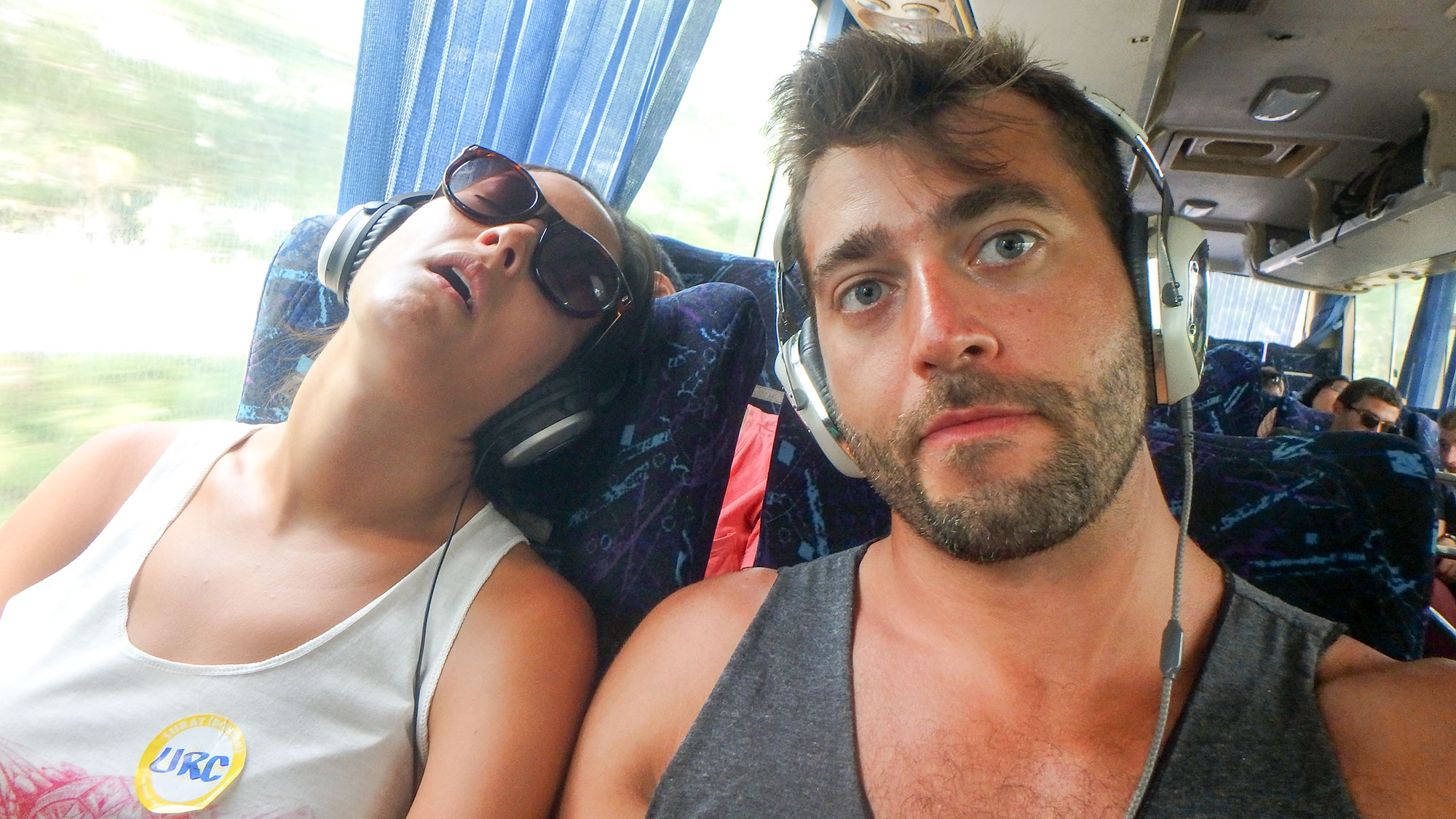
I can't help myself sometimes.
Then we took a songthaew to our hotel.
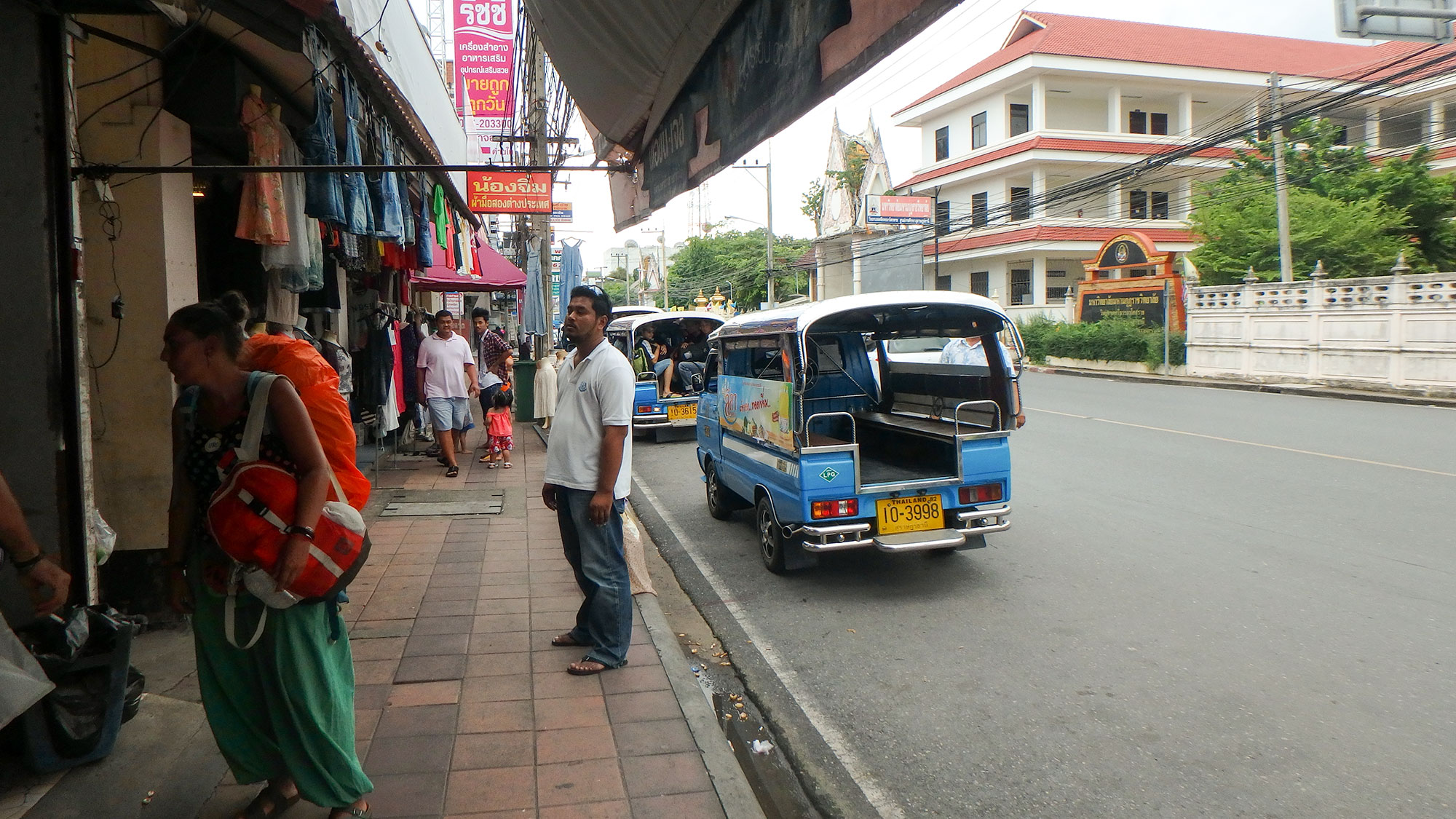
A songthaew is a pickup truck converted to transport with benches on each side. The songthaews in Surat Thani are baby pickups.
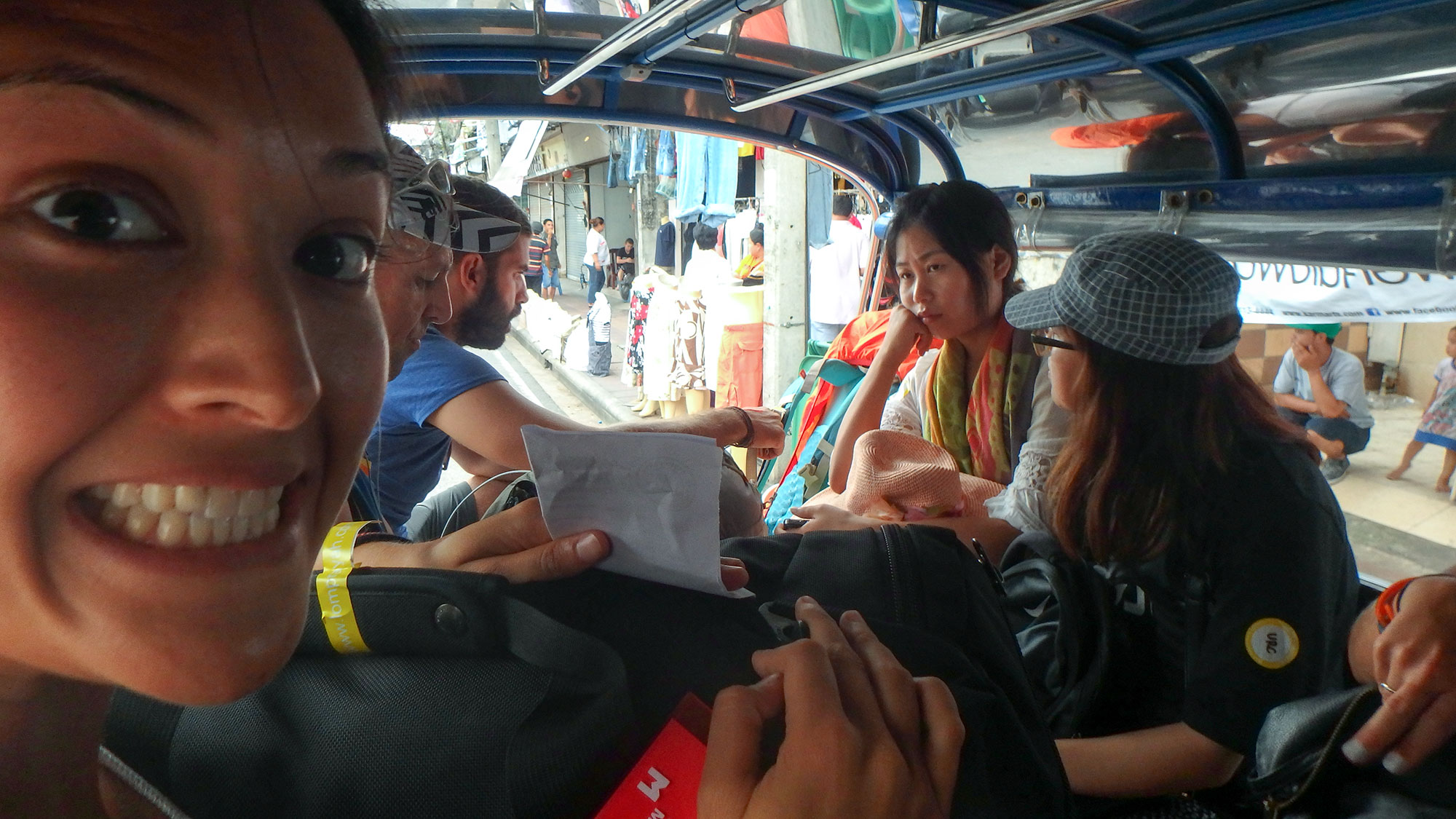
The guy wouldn't leave until he'd crammed in seven people plus luggage.
Day -1: Registration Day
The next morning, to our pleasant surprise, the songthaew driver understood us well enough to be waiting outside. One-stop shop: Suan Mokkh here we come!
Or so we thought. Fifteen minutes later, the driver deposited us on some back street in the middle of Surat Thani. Through some broken English, it seemed like he was saying a van would take us the rest of the way, supposedly departing at 10:00 AM. He kept pointing to a nondescript white van with no markings. How was that going to take us anywhere? I wondered. Before we had time to confer, the songthaew was gone.
Although we were confused, we didn't have any better ideas, so we sat down and waited.
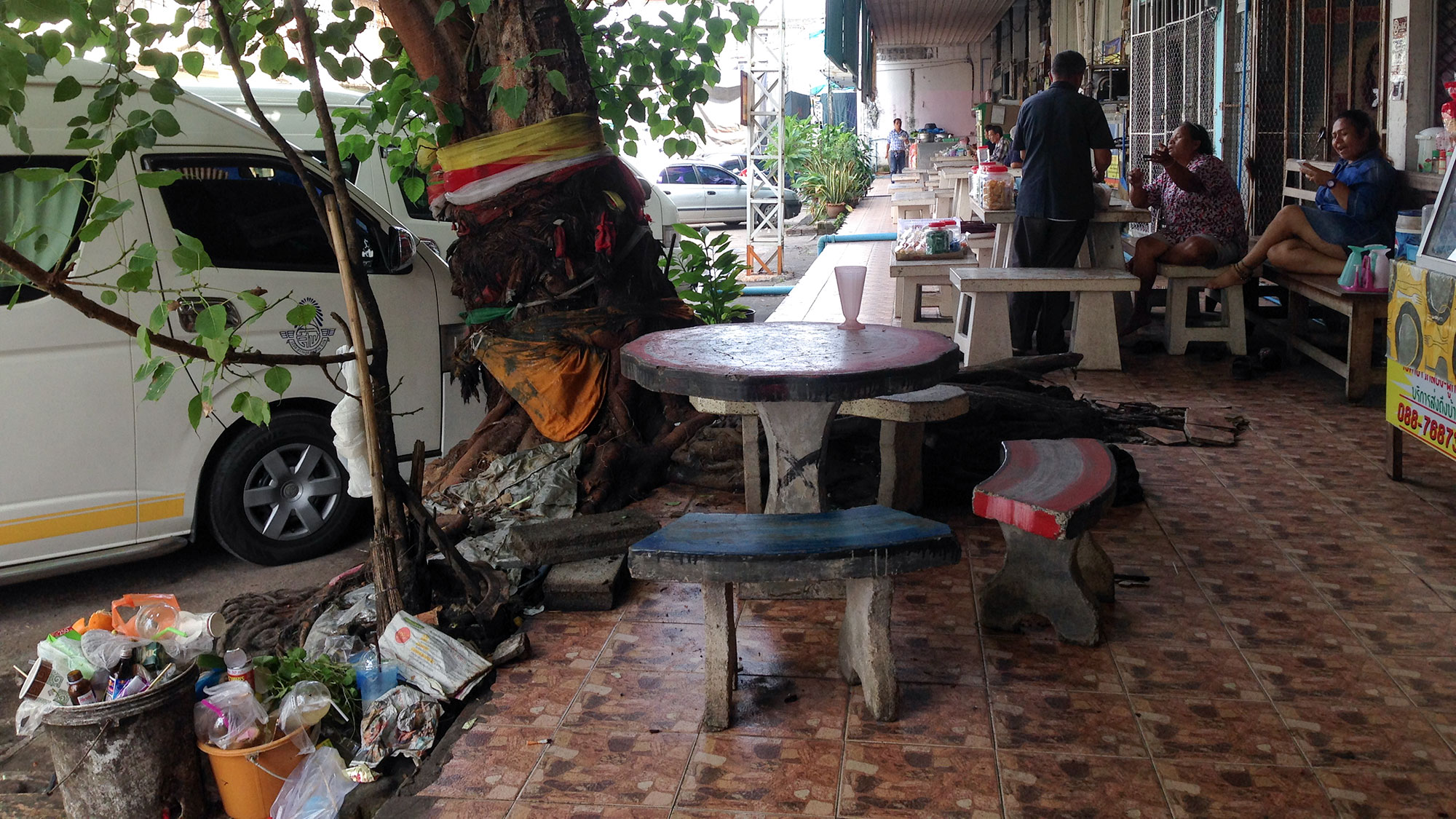
Where are we?
After a very long hour of being stared at by locals, people started to board the unmarked van. No one spoke enough English to confirm its destination, but we went for it anyways.
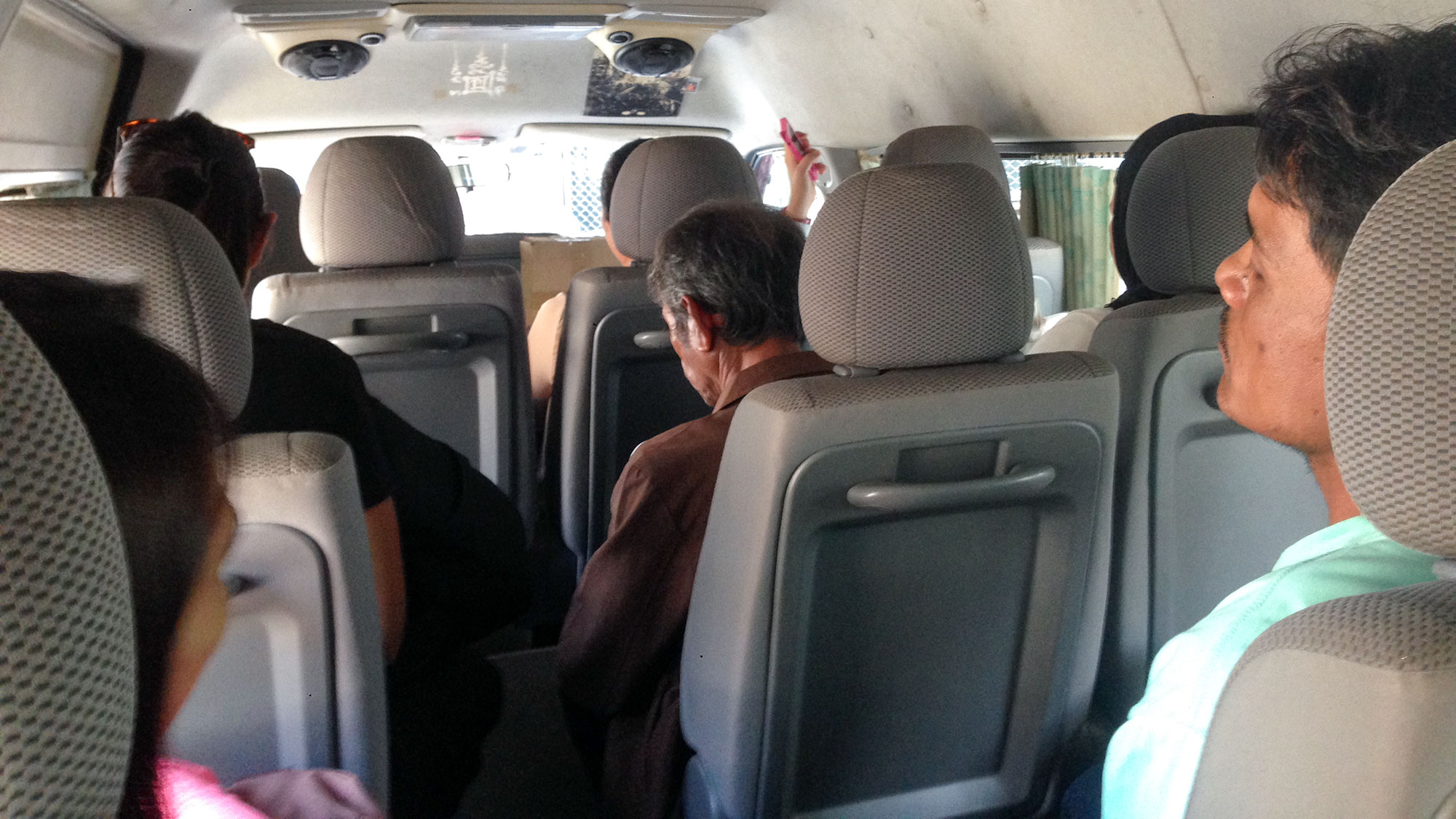
Meghan and I stuffed in, between the locals, luggage, and cargo.
Apparently these transport vans double as cargo delivery trucks. Every so often, the driver would pullover, drop a box on the ground, and resume driving. After an hour or so of this, he pulled over at some roadside stands and pointed to us. We had made it to the monastery. Now we just had to find the International Dharma Hermitage.
We spotted an unidentified road across the highway and went for it, not completely sure if it was the right way. About twenty minutes later, at 11:30 AM, we arrived at the Hermitage, dripping in sweat. It only took one ferry, one bus, two songthaews, a cargo van, and a short hike, but we made it.
This meditation retreat was actually happening.
Day -0.5: Orientation
We were greeted by one of the Hermitage's volunteers and began the lengthy registration process. This entailed reading over and filling in some forms, passing an interview, and handing over all our potentially distracting items for safekeeping during the retreat. We finished registering just in time for our first vegetarian lunch.
Meghan went to eat on the female side of the dining hall while I served myself a big metal bowl of Thai fried rice and sat down at the men's table. To my left, there was a group of about five or six younger guys, roughly 25 years of age, eagerly chatting away with nervous anticipation. I overheard one of them humblebragging about his spiritual tribulations as he "worked on himself" while another was describing his pre-retreat juice cleanse involving nothing but cayenne pepper, maple syrup, lemon juice, and a mild laxative. It was unsurprising conversation for a meditation retreat, I guess. I began to eagerly look forward to that vow of silence.
After lunch, I found Meghan waiting by our bags, noticeably upset. I asked what was wrong and, with a quiver of the lower lip, she mumbled that all the good chores were taken. Another feature of the retreat, borrowed from monastic life, is that each participant must perform a daily chore. These range from raking leaves, to wiping tables, to cleaning toilets. Meghan had read about the toilet cleaning in some blog post by a solo female traveler and she had been scared to death about it ever since.
Meghan thought she was stuck with cleaning toilets. We went back to the chore list together and upon closer examination, we discovered that she had overlooked a slot for cleaning tables after tea time. Whew, crisis averted. With that, we separated again to set up our respective dorm rooms.
The dorms are designed as a hollowed rectangle with about 40 rooms facing an internal courtyard.
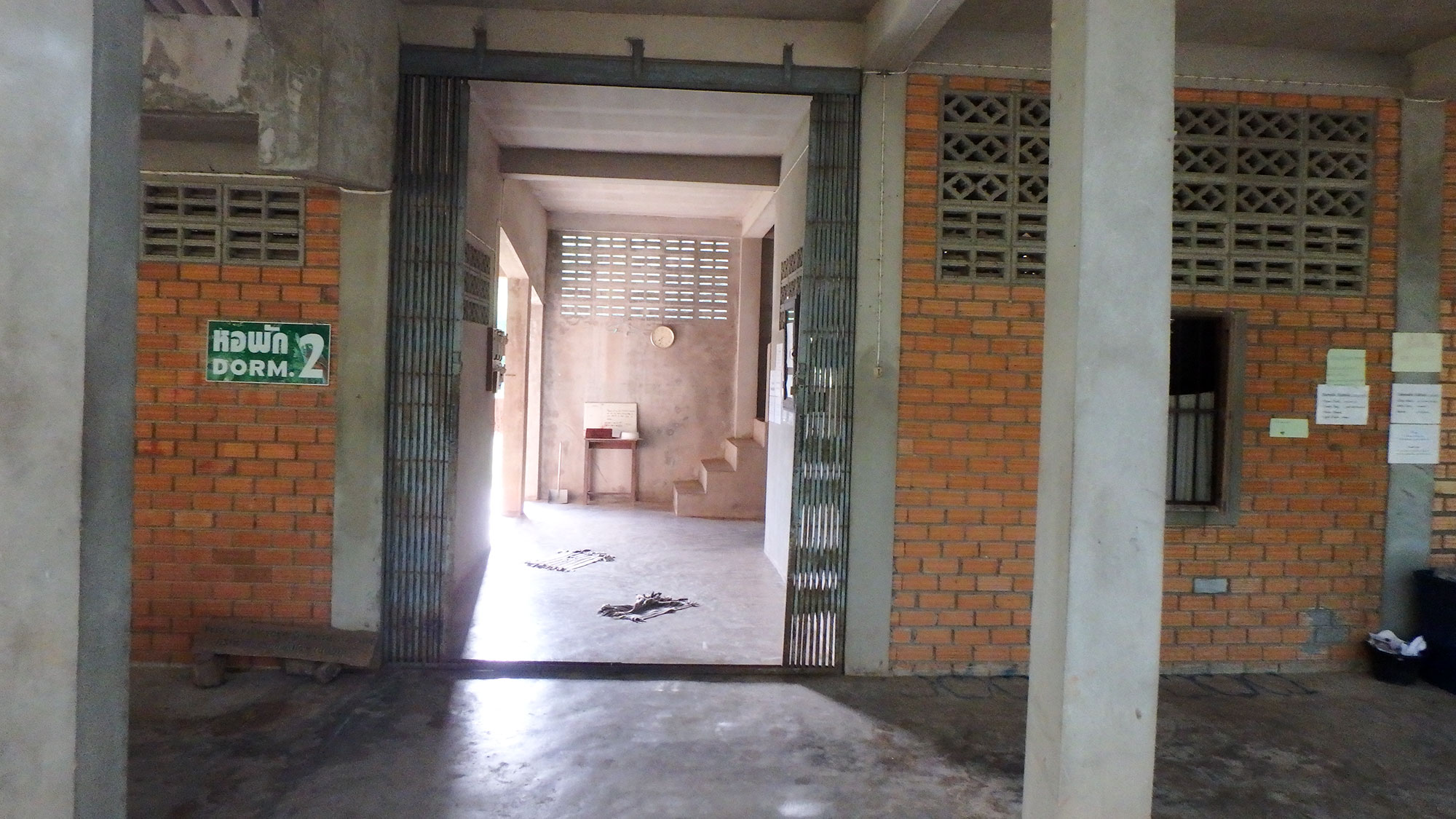
Entrance to the men's dorm. Notice the gates.
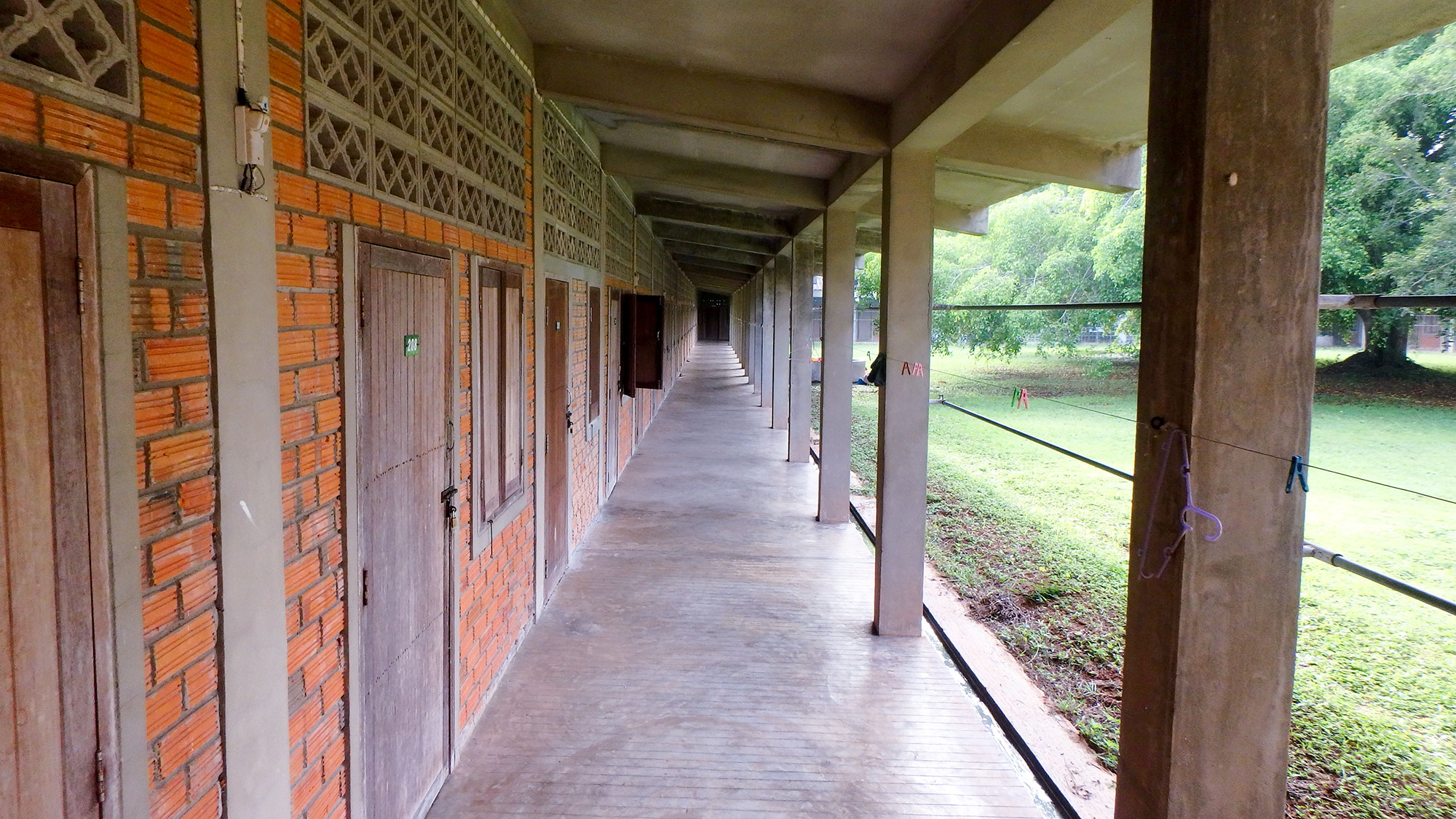
Dorm rooms to the left, courtyard to the right.
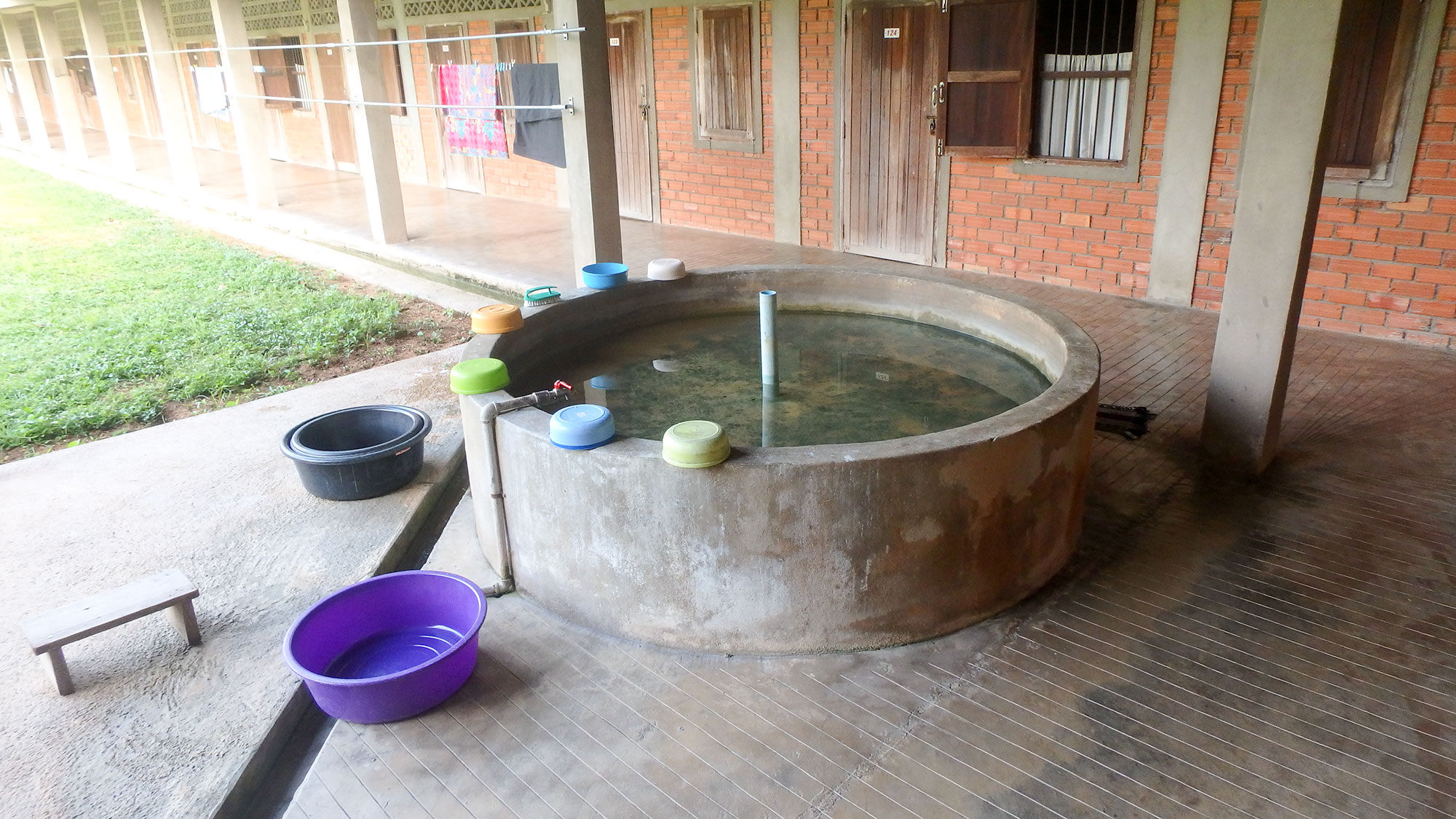
One of the freshwater pools for washing clothes or splashing your face, not for bathing.
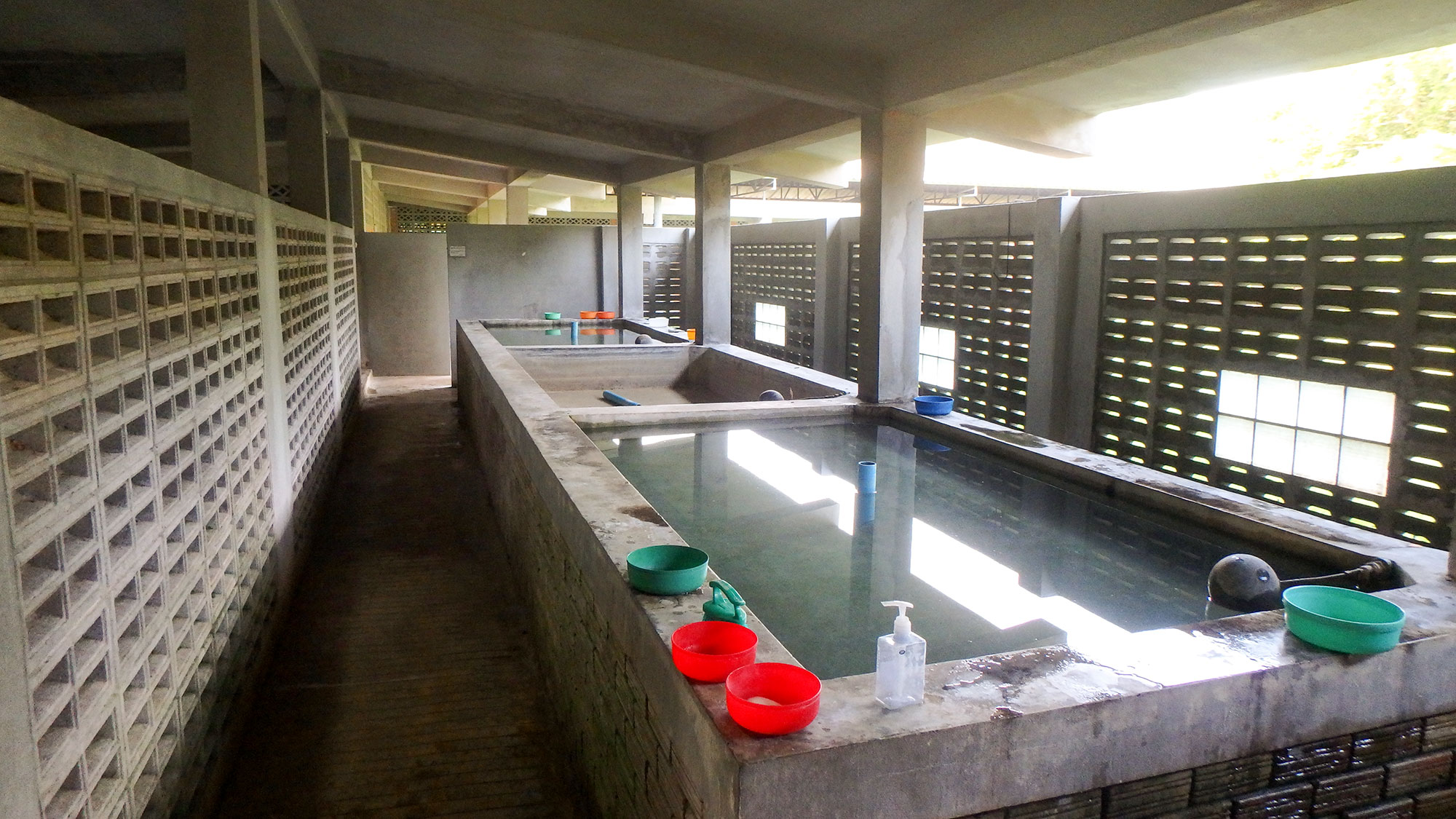
These are the pools you're allowed to use for bathing. You take one of those bowls, fill it up, and pour it over your head and body.

Nahhhhhhhh. This experience also introduced me to "manual toilets." A manual toilet is a toilet that doesn't have an automatic flush. You need to supply the water to flush it yourself. For the toilets at the Hermitage, flushing entailed filling a bowl with water and dumping it in the toiletbowl until everything drained away.
The individual rooms are as basic as it gets: bare, concrete construction measuring approximately 8' x 8' with a wire for hanging clothes, a lightbulb, a metal lantern, and a concrete platform with straw mat for sleeping. In addition, participants are issued a mosquito net, thin wool blanket, and wooden block. To make sleeping more comfortable, of course.
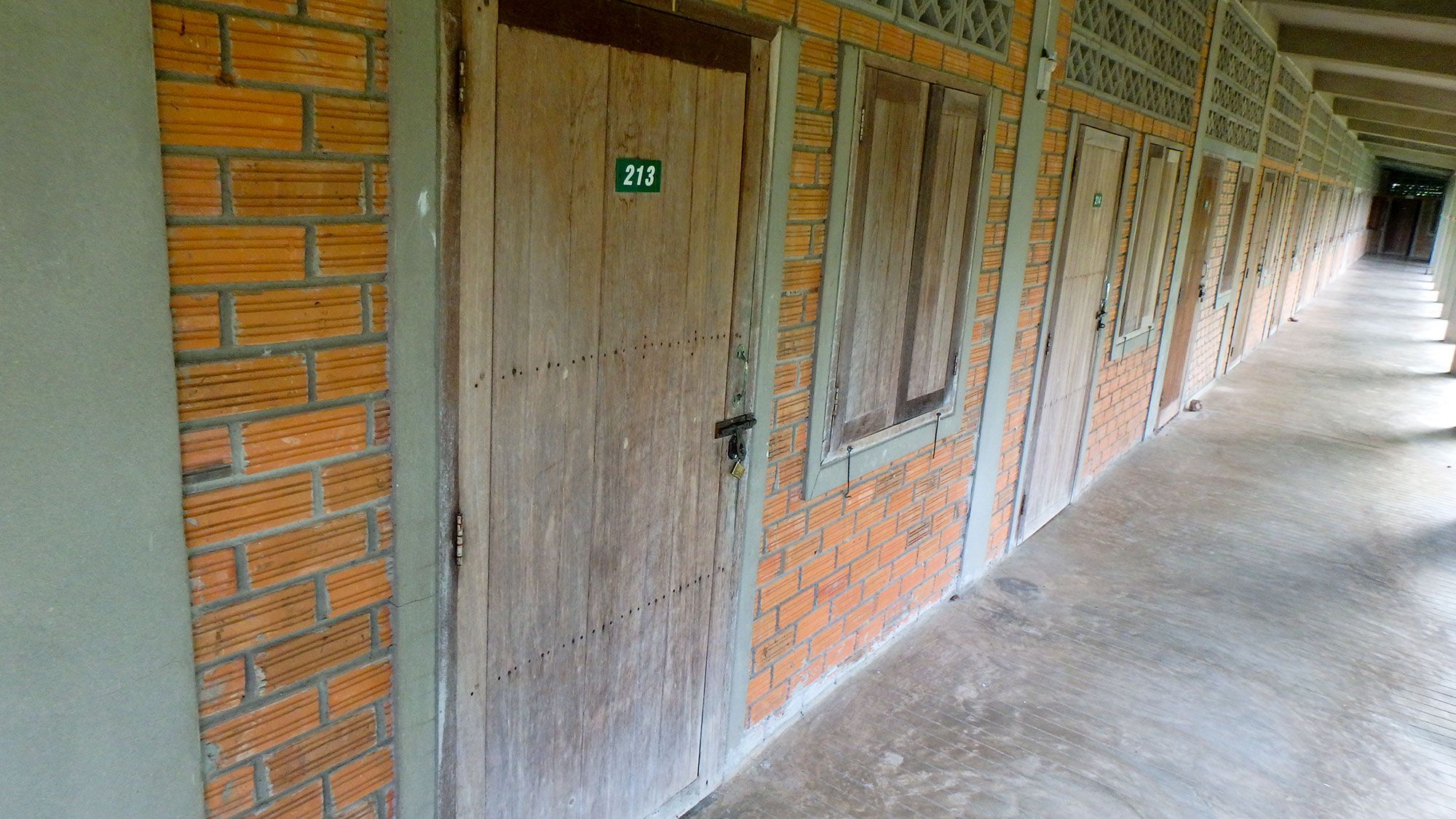
This was my room for the retreat, Cell 213.
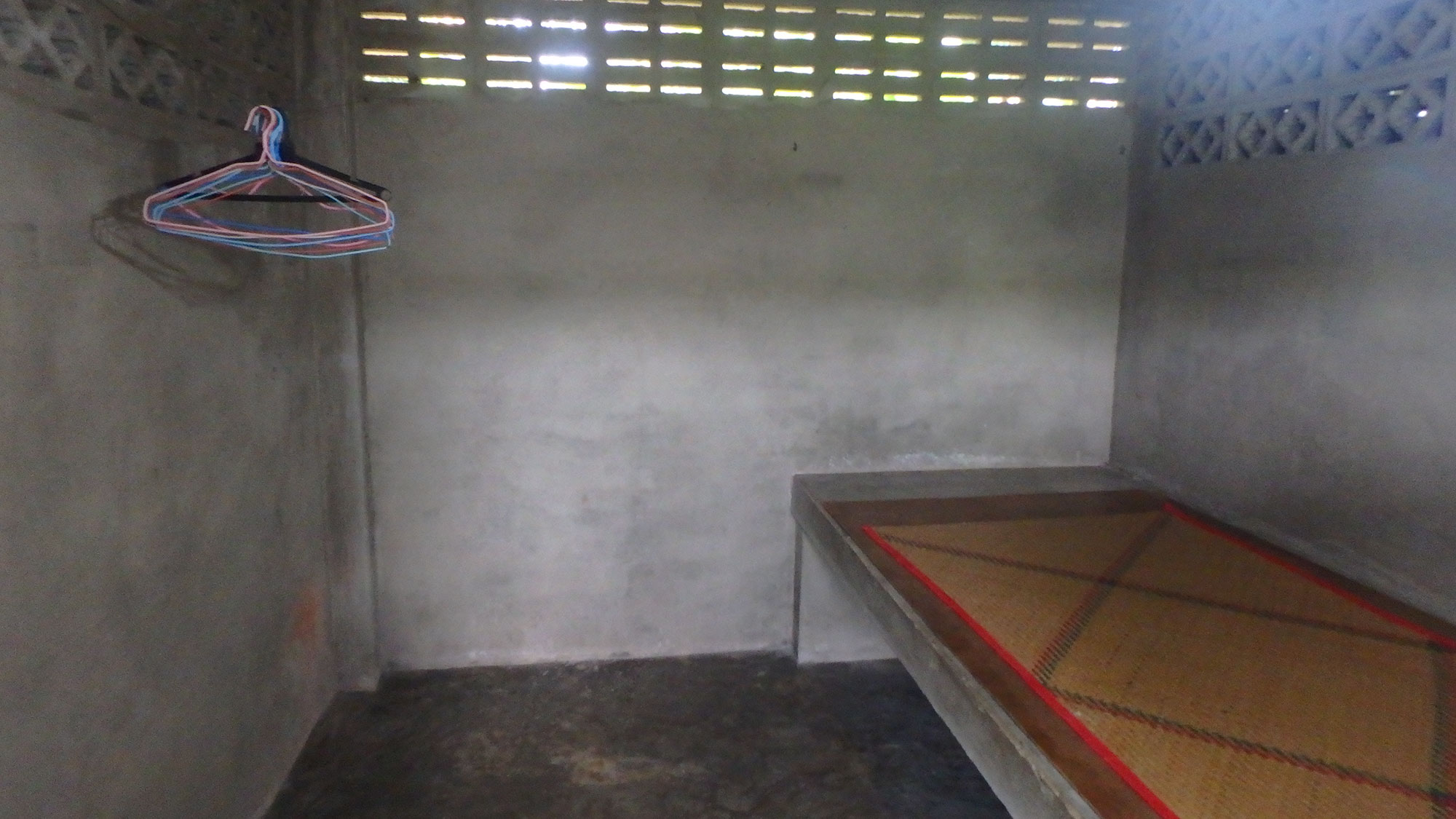
My room.
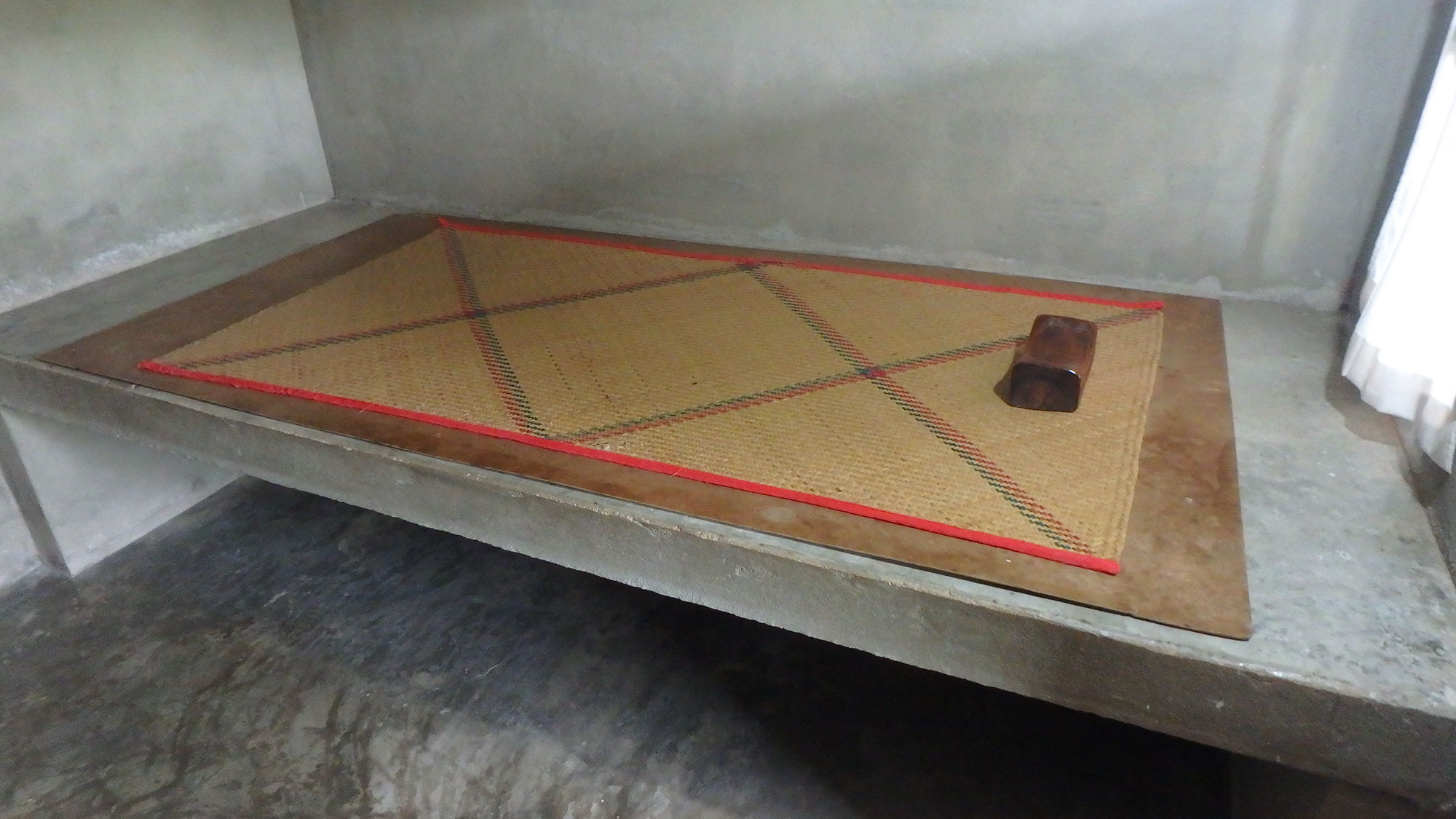
My bed. How many times have we all justified the purchase of an expensive mattress using the cliche, "You spend one-third of your life in bed?" This retreat experience got me thinking: what if we have it all wrong? What if we should purposefully buy an uncomfortable mattress so that we're motivated to get out of bed and reclaim some of life we otherwise spend asleep? I'm thinking about starting a new mattress brand based on this concept. This could be the next Casper. Email me if you want in on the ground level.
Upon entering my room for the first time, I was greeted by a harbinger of the wildlife to come: a black scorpion in the middle of the floor. (Close encounters with wildlife, particularly frightening wildlife, would prove to be a theme of my retreat experience.) Fortunately, I was still brimming with enough enthusiasm at this point to follow the rules and scoop up the scorpion into the specifically designated creature removal bowl. I carried him outside and gently flung him into the bushes. No killing, mind you, and that rule applies equally to insects.
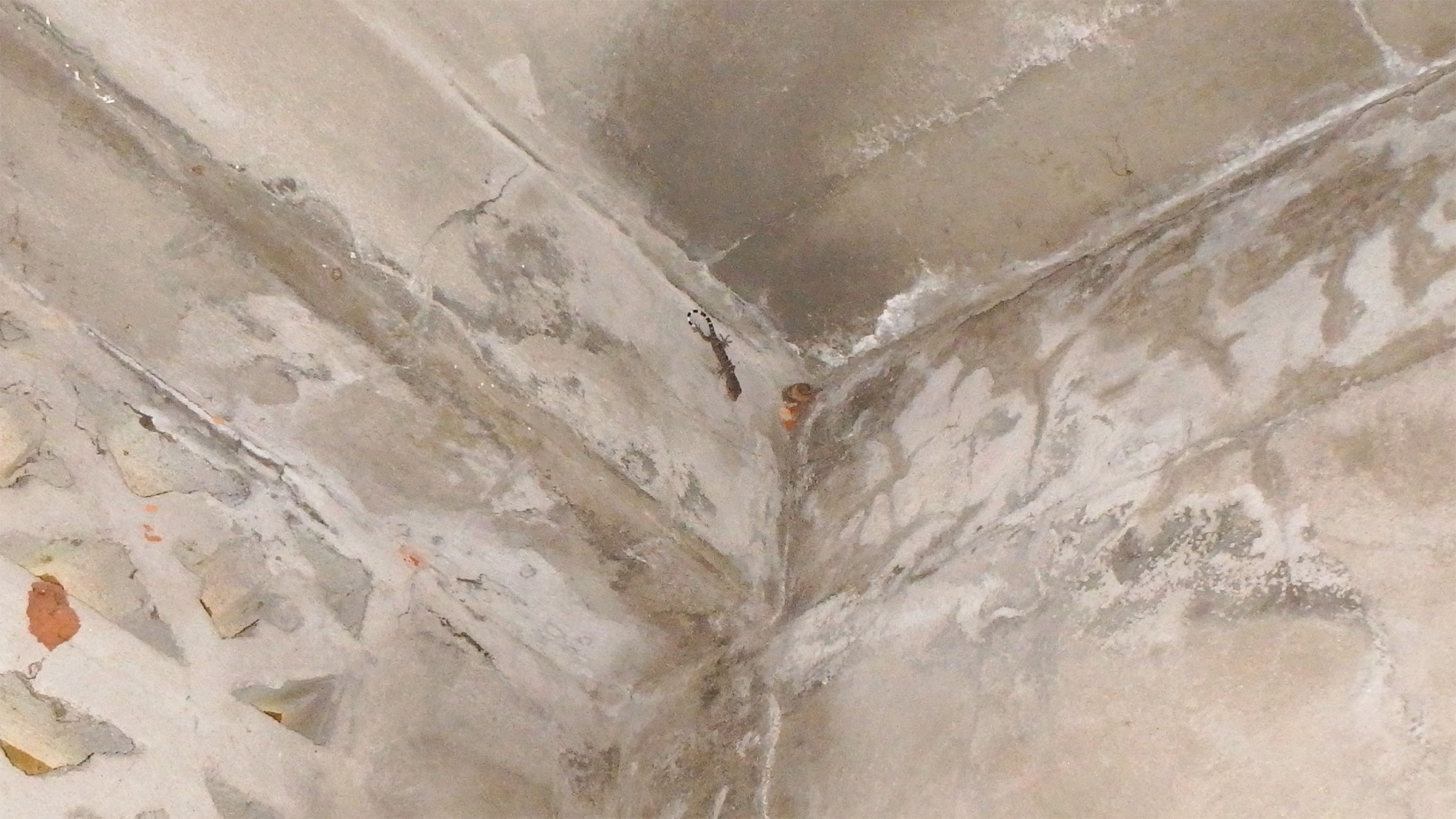
This baby gecko was gracious enough to make an appearance in my room during my photoshoot. His dad — the biggest gecko I have ever seen, at least 10 inches long — camped out in that corner for a majority of the retreat. Once I got used to the sight of a giant lizard hanging upside down in my room, I was happy to let him hunt insects. But the more I learned about living with giant geckos, the more I grew to hate it. They are much more annoying than you'd think. You have to read Part Two to learn why.
Dormitory life would not be complete without some rules.
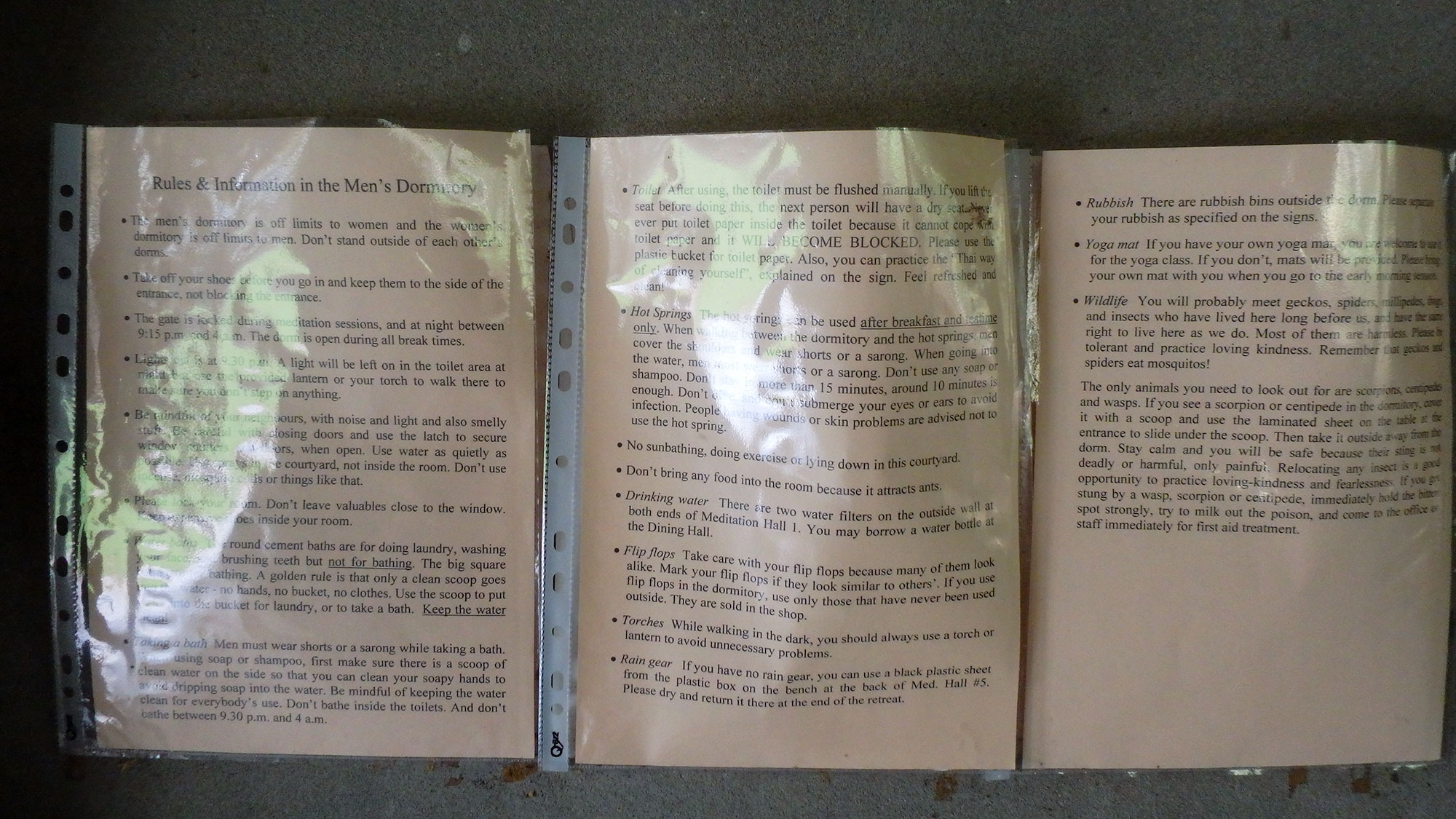
Sorry for the poor photo quality. I didn't have much time.
After setting up my room, the rest of registration day was kind of a blur. I remember sitting with Meghan during the early afternoon, anxiously waiting for things to begin. In retrospect, we were both so tense that we took this time together for granted, given the circumstances. After 45 days of being attached at the hip, almost literally, Meghan and I were about to be completely separated for ten days. No talking. No eye contact. No nothing.
Formal orientation began at 6:00 PM in the main meditation hall. It proceeded as you would imagine. One of the Hermitage volunteers sat upfront and congratulated us on our decision. She then tediously reviewed the many rules of the retreat and then tried to explain why they exist. The volunteer also cautioned us on the many pitfalls that we would likely encounter during the next ten days. Among other things, we were warned that it's normal to sometimes think you're going crazy.
After this introductory session, the men and women split up to tour the grounds with their respective dorm leaders. I was particularly excited to learn that you should always do a sweep of your room whenever you return because it's not uncommon to find a snake waiting. I'm being sarcastic, of course, because I have a bit of a phobia related to venomous snakes. Don't worry though, they consoled: it's only a cobra about half the time.
The group reconvened in the meditation hall. At 7:30 PM on Sunday, it was finally time to begin our ten day vow of silence. Since everyone was already listening silently, and there were no spoken vows or bells of any sort, this moment was unforgettably anticlimactic.
The vow was followed by tea time in the dining hall and a short video on the history of Buddhadasa Bhikku and the International Dharma Heritage. We then retired to our dorm rooms in silence. Lights out at 9:30 PM.
Only ten days to go...
To be continued.
Coming in Part Two:
- My horror as I realized that I voluntarily signed up for ten days of mock prison (with a far less comfortable bed)
- My rapture as I discovered that the clickbait Vice.com article wasn't entirely clickbait
- My desolation as I fell back to earth in an accelerated experience of the central Buddhist concept called dukkha
- My boredom as I sat through interminable hours of nothingness, followed by epiphany — the framework for a new personal philosophy
- And more!